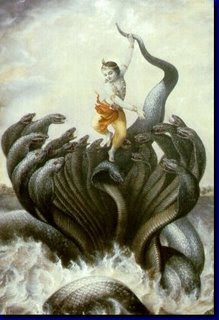Nagpanchami / Nagapanchami
 Nagpanchami also known as Guga-Navami is a ceremony celebrated by the Hindus all over India. It falls on the fifth day of moonlit fortnight in Shravan (July/August). Snake worship was a ritual practice long before the Vedic times; by Hindus, Jains and Buddhists and still continues to be a pious celebration. There are quite a few mythological stories that cause the devotees to pray the serpent. Lord Shiva wears the snake as ornamentation around his neck. The ceremonies performed include sweetened milk and puffed rice offered to the snakes. People pray the Snake God for prosperity and safety from the venomous reptile. Goodies including sweets, fresh fruits and dry fruits along with flowers are gift hampers often exchanged among the devotees. In the corporate sector, this occasion is a good time to promote the corporation or a business by personalized Nagpanchami gifts.
Nagpanchami also known as Guga-Navami is a ceremony celebrated by the Hindus all over India. It falls on the fifth day of moonlit fortnight in Shravan (July/August). Snake worship was a ritual practice long before the Vedic times; by Hindus, Jains and Buddhists and still continues to be a pious celebration. There are quite a few mythological stories that cause the devotees to pray the serpent. Lord Shiva wears the snake as ornamentation around his neck. The ceremonies performed include sweetened milk and puffed rice offered to the snakes. People pray the Snake God for prosperity and safety from the venomous reptile. Goodies including sweets, fresh fruits and dry fruits along with flowers are gift hampers often exchanged among the devotees. In the corporate sector, this occasion is a good time to promote the corporation or a business by personalized Nagpanchami gifts.
Important Aspects of Nag Panchami
This so called "snake day" has several important components. In addition to offerings made to the snakes throughout the country during worship and celebration, men and women celebrate the day in these ways:
Cobras are bathed in milk and offered rice as this is thought to offer immunity from their bites.
Women often partake in early baths of milk and wear colourful saris.
Pots of milk and flowers are placed next to holes that are believed to contain snakes as an offering of devotion. If a snake actually drinks the milk it is thought to be the ultimate sign of good luck.
Mansa, the Queen of Snakes, is worshiped in most parts of Bengal during Nag Panchami.
In the Punjabi region, a large dough snake is created and then paraded around the village. The parade is colourful with plenty of singing and dancing; at the end of the parade the snake is buried. Nag Panchami is referred to as "Guga-Navami" in Punjab.
Snake charmers sit alongside the roads of Maharashtra and encourage women to offer milk, flowers and haldi-kumkum (a powdered offering of tumeric and vermillion) to the dangerous snakes the snake charmers carry.
In many villages, snake charmers carry pots containing cobras to a central temple where they are released and then worshiped with offerings of milk and rice.
Mainly in the south of India, people worship figures of snakes made of clay or sandalwood as alternatives to the real-life versions.
No Hindu home may fry anything on the day of Nag Panchami.
Girls who are hoping to marry believe that the cobra offers good luck in their quest for eternal happiness.



 Panchami means the fifth and on the fifth day of the bright half of Shravana, nagas (serpents) are worshipped. Snakes symbolize energy and prosperity. Snake-worship is pre-Aryan and was incorporated into the Aryan religion at an early stage.
Panchami means the fifth and on the fifth day of the bright half of Shravana, nagas (serpents) are worshipped. Snakes symbolize energy and prosperity. Snake-worship is pre-Aryan and was incorporated into the Aryan religion at an early stage.









